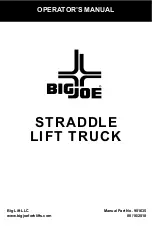
4.
A truck that appears to be leaning more than
the specified amount should be adjusted
promptly.
5.
Do not use the drive frame or operator compart-
ment as a point of reference for measuring the
height difference, as this may vary due to man-
ufacturing tolerances. Only use the specified lo-
cation on the forks.
6.
Variations in the floor can greatly affect the ad-
justment. If you are unsure how level your floor
is, move the truck to several different areas and
recheck the adjustment.
7.
For applications with reduced traction (wet,
cold, dirty), an appropriate drive tire should be
chosen to improve traction. Over-adjusting the
caster is not a substitute for drive tire selection.
Caster Adjust Procedure
1.
Perform Caster Adjustment Check procedure
prior to adjusting caster.
2.
Remove all weight from the forks and lower the
forks completely.
3.
Select a smooth and level surface where proce-
dure can be performed.
4.
Turn the key switch to the OFF position and
disconnect the battery. (DO NOT remove the
battery.)
5.
Using a low clearence floor jack, raise the right-
side of the truck so the caster is not touching
the ground (about 6 to 13 mm (0.250 to
0.50 in.)). Install blocks under the frame to sup-
port the lift truck. See Figure 14.
6.
Remove floor mat and raise the floor plate and
ensure it is securely supported. See Figure 15.
Figure 14. Raise Lift Truck
Figure 15. Floor Plate
8000 SRM 1705
Maintenance Procedures Every 250 Hours or Every 6 Weeks
19























